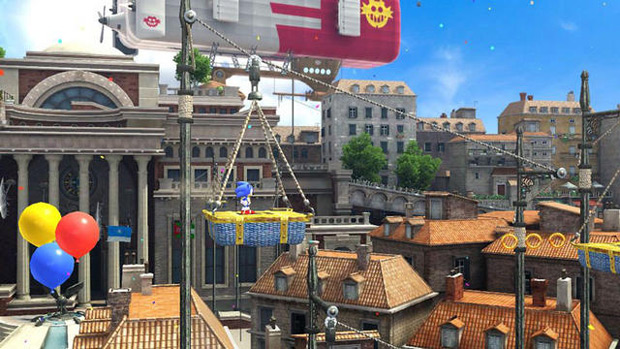Since Sonic Generations was first announced back in April, the heartstrings of many fans have yet again been pulled one way or another, as they hope that Sega doesn’t screw up yet another Sonic game. Even our very own Jim is in disarray, convinced that this game — due out on November 1 — is in fact “an elaborate trap!“
While Hamza was busy trying out the 3DS version a few weeks ago at TGS, producer Takashi Iizuka had a nice long chat with Japanese site Inside Games about the title’s development and all things Sonic. Though there seems to be a Sonic game released every year these days, Iizuka stipulates that with this game’s being made for Sonic’s 20th Anniversary, he wanted to make something different: “A game that incorporates memories from all 20 years into one package. Recreating the old games with the latest technology, and trying to create an experience that will allow you to enjoy how you played originally as well as provide more surprises when replaying.”
He also understands that there are clearly two sets of fans — 2D Sonic veterans and the more recent 3D fans. To appeal to both and to allow them to celebrate Sonic together, they “tried to incorporate both classic and modern stages into the game.” However, he also acknowledges that “to cross over both generations of Sonic, the game will also be crossing a taboo! [laughs]”

Nostalgia is the name of the game — trying to accurately recreate the stages and music of Sonic that made it iconic so long ago, while adding a few tweaks here and there. Regarding stage creation and selection, Iizuka said that there would inevitably be bias from whichever development team they chose to select the stages. Therefore, they collected opinions from Sega of America, the British division of Sega Europe, Internet surveys, and ordinary fans.
There are nine stages in total — three each from the Genesis era, the Dreamcast era, and the current era, with bosses and additional rival stages from those periods as well. Iizuka hopes to include plenty of surprises along the way, using Sonic Adventure 2‘s City Escape stage as an example, in which the truck at the end was never planned. Trying to convert 3D roaming stages like this one into 2D allows the developers to have fun incorporating ideas and trying to create completely new stages.
The interviewer here pointed out that not many 3D-roaming games revert back to 2D-sidescrolling nowadays, to which Iizuka agrees that the strength of 3D action games means that there “may be some inevitable damage in making a 2D game” and that “wondering how we could make it just as enjoyable was difficult.” However, he has faith in his young team of developers, who have played all the stages to death, are aware of all the good and bad parts from Sonic over the last two decades, and are now in charge of level designs themselves.

Moving onto stereoscopic 3D, Iizuka laughs that he was its only advocate. He saw some exciting developments after a bit of trial and error, particularly with the depth that 3D can offer, allowing to “easily produce a sense of distance,” and thus in his view, “making stereoscopic 3D and action games a pretty good combination.” Though the 3DS version shares the first stage — Green Hill Zone — with the home consoles — all other stages are exclusive to either console or handheld. This is due to the different 2D and 3D configurations, leading to two types of 2D stages — modern (Sonic Rush style) and classic. Iizuka reassures 3DS lovers that “there will be plenty of mechanisms incorporated to make you aware of 3D objects,” leading the 3DS version to be what is essentially “three-dimensional sidescrolling action.”
After Iizuka mentions the special compilation CDs — available in Japan and Europe and consisting of music from the first stages of every Sonic game, as well as minor songs that have never been included in previous collections — the interviewer concludes by asking Iizuka how he sees Sonic evolving and whether we’ll see more of him in the future. He comments that they’re seeing good things both in 2D and 3D and that he wants to continue the trend of releasing games in both forms, such as Sonic the Hedgehog 4: Episode 1 and Sonic Colors last year. He confirms that work on Sonic the Hedgehog 4: Episode 2 has started and that he wants to “make 3D action games that will surprise you in a good way.”

Though reassuring us that the core Sonic franchise’s being action-oriented will not change, he understands that each genre is limited by the number of customers it has. He wishes to see Sonic expand into other genres and wants to see non-action genre players say, “I know that blue character!” He ends by saying that “we want to challenge other genres apart from the Olympics! [laughs]”
So after all this, plus some inside info from a confidant in Sega Europe who said that the company is really putting all its heart into this game, are any of you confident enough to say that this game will be awesome, are you going to stay cautiously optimistic like Jim, or do you just feel it’s too late for Sonic? Tell us how you feel about seeing Sonic in other places, and give us examples of where he could or should feature.
A Challenge only for the 20th Anniversary — Interview with Sonic Generations Producer Iizuka [Inside Games][JP]


